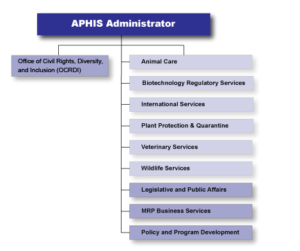What’s APHIS?

One of the legislative issues that I have been following closely with Alex Sands, one of the amazing Assistant Directors at the AVMA GRD, is the Budget and Appropriations Act. One of the key components within the act affecting veterinary medicine is the appropriations of money to critical USDA programs.
There are a number of important offices and programs within USDA. For today, I am going to focus on the Animal and Plant Health Inspection Services (APHIS), which falls under the Marketing and Regulatory Programs, which Laura and I had the opportunity to visit in Riverdale. We had an exciting, tight-packed day meeting with veterinarians from the various branches of APHIS. This experience was a great opportunity to tie together what I had been working with Alex on – advocating for the steady funding of these key governmental programs, with a clearer understanding of the need for, and practical implications of these funds.
APHIS was established in 1972 as an agency to protect U.S. agriculture, which helped bring together the work of multiple animal and plant health bureaus within USDA with the same role. Under APHIS, there are 6 operational programs units including Animal Care (AC), Biotechnology Regulatory Services (BRS), International Services and Trade Support Team (IS), Plant Protection and Quarantine (PPQ), Veterinary Services (VS), and Wildlife Services (WS). Veterinarians work across multiple branches, playing an important role on the human-animal interface by ensuring the health and welfare of production animals across the US, including keeping out Transboundary Animal Diseases, and as a result, ensuring a safe food supply for both people in the country, and the U.S’ trading partners across the globe.
During our visit, amongst the veterinarians who we met, was Dr. Rachel Cezar, Director of Live Animal Imports under Veterinary Services. She plays a crucial role in regulating the import of live animals, semen and embryos while serving as a trade consultant on both a national and international setting. Dr. Rachel Cezar has worked in other segments of APHIS, including Animal Care, where she was a leader in enforcing the Horse Protection Act to eliminate the practice of “soring” in horses. Dr. Cezar started her career at APHIS serving as a Veterinary Medical Officer, a role under Veterinary Services, where she worked firsthand in surveillance of critical public health diseases such as Chronic Wasting Disease and Scrapie. A key player in this role of diagnosing exotic and economically devastating diseases is the National Veterinary Services Laboratories (NVSL) under Veterinary Services, and the National Animal Health Laboratory Network (NAHLN), which respond to animal disease outbreaks such as HPAI, which are amongst the programs that the AVMA is advocating for sufficient funding.
There were a lot of acronyms in this blog-post, and lots of structure to make sense of, so I have included a chart, through USDA’s website, of the general organization of USDA, and one of the general organization of APHIS, which will hopefully help clear things up.
However, the main point that I wanted to bring across, is the importance of the work that these agencies perform, which often goes unrecognized due to much of the work being performed from behind desks or facilities that are not regularly accessed by the public. However, if you are a consumer of animal products, crops, or a horse owner, or farm owner, or have a pet that has traveled between states, you have been influenced by USDA. The assurance of food safety, animal welfare and response to devastating disease outbreaks, can all be attributed to the wonderful work of personnel within USDA – many of whom include veterinarians, that we had the pleasure of meeting and getting to know on a face-to-face basis, making their mysterious work more relatable and transparent; their hard work, passion, and evidence of the importance of what they do, has inspired me to consider a career within APHIS, perhaps in the International Services department, where I can work alongside developing countries as I hope to do.


